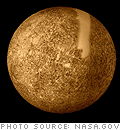Mercury

 |
Mercury is the planet nearest the Sun. Appropriately named for the wing-footed Roman messenger of the gods, Mercury whizzes around the Sun at a speed of 30 miles per second, completing one circuit in 88 days. The days and nights are long on Mercury. It takes 59 Earth days for Mercury to make a single rotation. It spins at a rate of about 6 mph (about 10 km/h), measured at the equator, as compared to Earth's spin of about 1,000 mph (about 1,600 km/h) at the equator.
The photographs Mariner 10 (1974–1975) radioed back to Earth revealed an ancient, heavily cratered surface on Mercury, closely resembling our own Moon. The pictures showed huge cliffs, or scarps, crisscrossing the planet. These apparently were created when Mercury's interior cooled and shrank, compressing the planet's crust. The cliffs are as high as 1.2 mi (2 km) and as long as 932 mi (1,500 km). Another unique feature is the Caloris Basin, a large impact crater about 808 mi (1,300 km) in diameter.
Mercury, like Earth, appears to have a crust of light silicate rock. Scientists believe it has a heavy iron-rich core that makes up about half of its volume.

Instruments on board Mariner 10 discovered that the planet has a weak magnetic field and a trace of atmosphere—a trillionth the density of Earth's and composed chiefly of argon, neon, and helium. The spacecraft reported temperatures ranging from 950°F (510°C) on Mercury's sunlit side to –346°F (–210°C) on the dark side. Mercury literally bakes in daylight and freezes at night.
Until the Mariner 10 probe, little was known about the planet. Even the best telescopic views from Earth showed Mercury as an indistinct object lacking any surface detail. The planet is so close to the Sun that it is usually lost in the Sun's glare.
Radar images taken by astronomers at Jet Propulsion Laboratories and California Institute of Technology during the summer of 1991 suggest that the polar regions of Mercury may be covered with patches of water ice. Although this seems impossible due to the planet's sizzling heat, the polar regions receive very little sunlight and may get as cold as –235°F (–148°C). The radar images showed bright patterns at the poles that are characteristic of ice reflecting radar signals. Other explanations may be offered for this unexpected discovery.
NASA's Messenger, the first Mercury mission in more than 30 years, was successfully launched on Aug. 3, 2004, and is scheduled to go into orbit in March 2011. Mercury will be almost completely mapped in color and images taken of areas missed by Mariner. Messenger will also measure the composition of the surface, atmosphere, and magnetosphere.
Mercury is visible to the naked eye at morning or evening twilight when it is at its greatest elongation.







